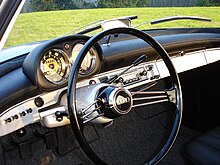DKW 3 = 6 Monza
| DKW | |
|---|---|
|
DKW Monza Schenk # 12
|
|
| 3 = 6 Monza | |
| Production period: | 1956-1958 |
| Class : | Sports car |
| Body versions : | Coupe |
| Engines: |
Otto engine : 0.9 liters (29 kW) |
| Length: | 4090 mm |
| Width: | 1610 mm |
| Height: | 1350 mm |
| Wheelbase : | 2350 mm |
| Empty weight : | 780 kg |
The DKW Monza is a 2 + 2-seater sports car from Auto Union on the chassis of the "Big DKW 3 = 6" ( F93 ). It is named after the world-famous Italian Grand Prix circuit . With this vehicle, five world records were set in 1956.
After the series of victories in 1954 and 1955 with the F91 special class in European touring car and rallying , two racing drivers began to develop a sporty body for the successful model. Günther Ahrens and Albrecht W. Mantzel designed a vehicle based on the 3 = 6 with an extremely light plastic body.
The complete vehicles were first manufactured by Dannenhauer & Stauss in Stuttgart, then by the DKW dealer Fritz Wenk, who had them built by Massholder in Heidelberg and most recently by Robert Schenk in Stuttgart-Feuerbach.
Wenk had to stop its Monza production in 1958 after the Auto Union 1000 Spezial was presented in 1957 and Auto Union refused to provide additional new chassis for the Monza.
Records
In December 1956, two Germans and two Swiss took turns driving a DKW Monza around the Monza Motodrom - for 72 hours without stopping the clock and without interruption, albeit with fuel stops and driver changes. At an average of 140 km / h, the driver team set five international records.
Essentially, the record-breaking racer came as standard, i.e. a DKW 3 = 6 in terms of the chassis. The fiberglass-reinforced polyester coupé body, however, had less air resistance than the standard body, making the car faster than normal DKWs. Like all DKW of those days, the Monza had a tubular frame made of box sections with outward (= front and rear) cranked longitudinal members ("fish belly frame"), but weighed only 780 kilograms at four meters in length, 1.61 meters in width and 1.35 meters in height , 115 kilograms less than the 3 = 6 sedan. The front wheels were suspended from wishbones at the bottom and a transverse leaf spring at the top, and there was rack and pinion steering, while a rigid axle with a raised transverse leaf spring was installed on trailing arms at the rear . All wheels were provided with hydraulically operated drum brakes (front duplex ).
With three cylinders, a displacement of 900 cc and 40 hp, the series sedan drove a top speed of 125 km / h. The sprint from 0 to 100 km / h took 31 seconds. With the same engine, the Monza was 140 km / h and accelerated from 0 to 100 km / h in 20 s.
Technical specifications
| model | 1.0 |
| Number of cylinders | R3 |
| Displacement (cm³) | 980 cc |
| Max. Power (kW / PS) at 1 / min | 32/44 at 4500 |
| Max. Torque (Nm) at 1 / min | 84 at 2100 |
| Top speed (km / h) | approx. 145 |
| Gearbox (standard) | 4-speed gearbox |
| Acceleration (0-100 km / h) | 22.0 s |
| Combined consumption (l / 100 km) | 8.0 |
| price | 10,390 DM (1957) |
Source: ClassicCars, owned by AutoZeitung
Number of items produced
There are conflicting reports about the quantities produced. One of the reasons for this is that there was never any precise documentation about it. Different manufacturers produced the vehicles at different times. To make matters worse, it was also possible to convert used vehicles from Schenk to Monza.
According to Auto Union GmbH, there were 230 to 240 vehicles, of which around 40 to 50 still exist worldwide.
Web links
Individual evidence
- ↑ http://www.dkw-autos.de/prospekte/grDKW4/grDKW4_20.jpg
- ↑ [1] ( Page no longer available , search in web archives ) Info: The link was automatically marked as defective. Please check the link according to the instructions and then remove this notice.
- ↑ Gebauer / Buck: Die Fahrgestelle der Personenkraftwagen, Chr.Belser Verlag Stuttgart 1956, p. 147 ff.




